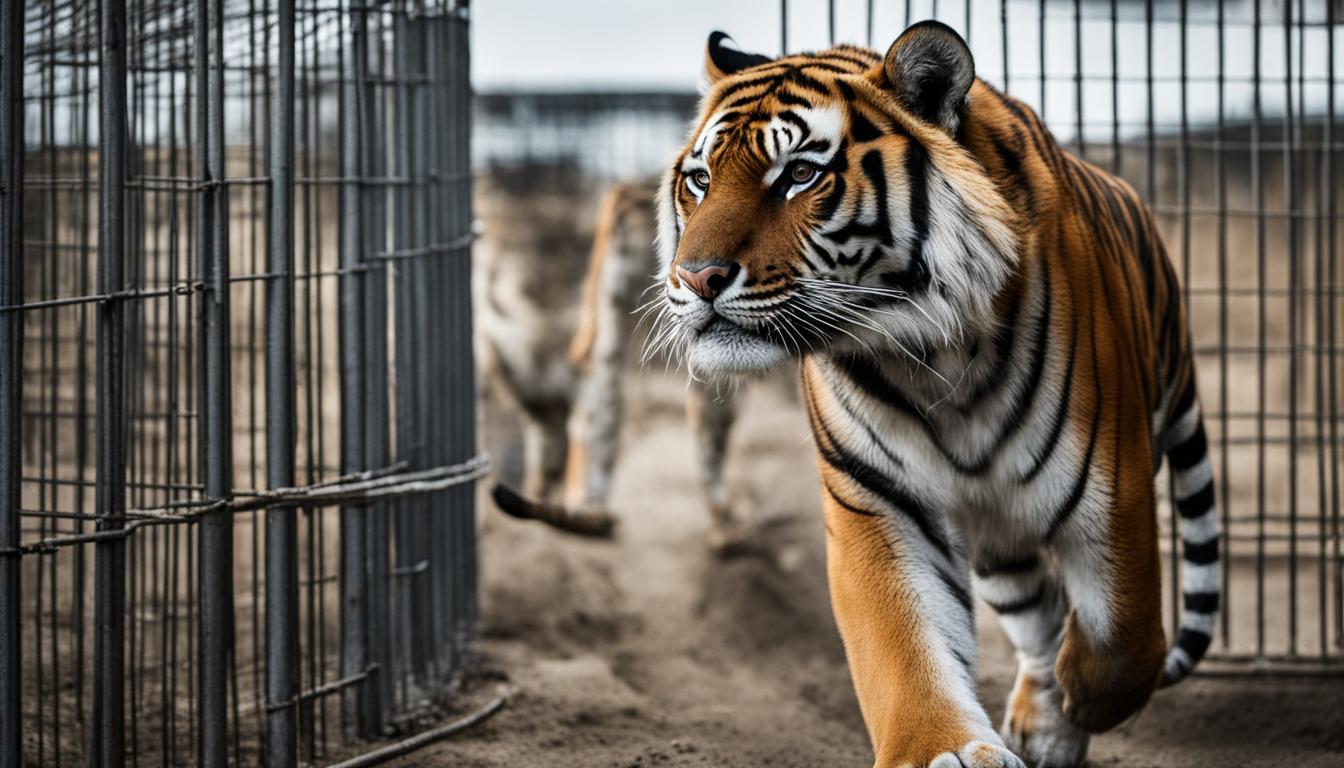Tigers are one of the largest species of cats in the world and are found in various subspecies across Asia. Currently, there are three subspecies of tigers managed by AZA-accredited zoos: Amur, Malayan, and Sumatran. However, tigers in captivity face numerous challenges and are classified as critically endangered or endangered on the International Union for Conservation of Nature’s Red List.
Key Takeaways
- Tigers in captivity are facing significant challenges and are classified as critically endangered or endangered.
- AZA-accredited zoos manage three subspecies of tigers: Amur, Malayan, and Sumatran.
- The issues faced by captive tigers include mistreatment, inadequate regulations, and the exotic pet trade.
- Captive tigers experience psychological and physical harm due to restricted living conditions and lack of environmental enrichment.
- Improving regulations, enforcing stricter standards, and supporting tiger conservation efforts are crucial for their welfare and long-term survival.
The Incidence of Captive Tigers in the US
When it comes to the number of tigers in captivity, the United States takes the lead. With an estimated population of around 7,000 tigers, the US has more captive tigers than the total number of wild tigers worldwide. This staggering figure is nearly double the estimated population of wild tigers, which currently stands at around 3,890.
It is important to note that this population includes tigers residing in both zoos and as privately owned pets. While zoos play a role in conserving and protecting these majestic creatures, it is the ownership of tigers as pets that contributes significantly to the high number of captive tigers in the US.
Texas, in particular, has become known for its large population of captive tigers. The state’s lax regulations regarding the ownership of exotic animals have made it an attractive destination for private individuals seeking to keep tigers as pets. This lack of strict regulation has resulted in a higher concentration of captive tigers in Texas compared to other states.
| State | Number of Tigers |
|---|---|
| Texas | 2,000 |
| Florida | 400 |
| California | 300 |
Table: Number of Tigers in Select States in the US
Issues and Controversies Surrounding Captive Tigers
When it comes to tiger captivity, there are numerous issues and controversies that need to be addressed. One of the major concerns is the mistreatment of captive tigers. In the United States, many tigers are kept as pets without being registered or regulated. This lack of oversight and enforcement often leads to poor welfare conditions and inadequate nutrition for these magnificent creatures.
Furthermore, there are significant concerns regarding public safety. Captive tigers have been involved in attacks and injuries to humans, highlighting the risks associated with the ownership of exotic animals. The trade in exotic pets, including tigers, perpetuates these issues by fueling the demand for captive animals.
In order to tackle these challenges, it is crucial to implement stricter regulations around tiger ownership. This includes ensuring that standards for enclosures and care are enforced, and that owners are held accountable for the welfare of their captive tigers. Additionally, efforts should be made to raise awareness about the conservation challenges faced by tigers in captivity, and the importance of supporting reputable tiger sanctuaries that prioritize the well-being of these animals.
“The mistreatment of captive tigers is a significant concern.”
By addressing these issues and controversies head-on, we can work towards improving the welfare of captive tigers and promoting responsible tiger conservation practices. It is essential that we take action to protect these magnificent creatures and ensure their long-term survival, both in captivity and in the wild.
The Impact on Captive Tigers
Captive tigers endure significant physical and psychological challenges, which have a profound impact on their health and well-being. The confined living conditions, lack of environmental enrichment, and forced interactions with humans can lead to chronic stress, resulting in detrimental effects on their overall health. Additionally, these conditions often trigger stereotypical behaviors and increased aggression among captive tigers.
Psychological well-being is crucial for captive tigers, as it directly affects their quality of life. Without proper mental stimulation, tigers may exhibit repetitive behaviors such as pacing, self-mutilation, or excessive grooming. These behaviors are signs of distress and indicate poor psychological well-being. The restrictive nature of captivity hinders their natural instincts and abilities to engage in essential behaviors like hunting and exploring their surroundings.
Moreover, the lifespan of captive tigers is significantly shorter compared to their wild counterparts. In the wild, tigers can live up to 15-20 years, while in captivity, their average lifespan is reduced to around 10-15 years. The stressors of captivity, improper diet, and lack of space contribute to various health issues, including obesity, dental problems, and weakened immune systems.
| Health Issues Faced by Captive Tigers | Effects on Tigers |
|---|---|
| Obesity | Increased risk of heart disease and joint problems |
| Dental Problems | Pain, difficulty eating, and infections |
| Weak Immune System | Higher susceptibility to diseases |
| Reproductive Issues | Difficulty breeding and reduced genetic diversity |
In an attempt to combat the decline of wild tiger populations, captive breeding programs have been established. While these programs aim to increase the numbers of tigers, they often result in inbreeding and genetic abnormalities. Lack of adequate genetic diversity can lead to health issues and further endanger the population rather than contributing to their conservation.
In conclusion, the impact of captivity on tigers is profound and detrimental. To ensure the welfare and conservation of these majestic creatures, it is crucial to address the psychological and physical challenges they face. Implementing measures to provide proper enrichment, nutrition, and spacious enclosures can greatly improve their well-being. Additionally, efforts should be made to regulate captive breeding programs to avoid genetic issues and prioritize conservation rather than commercial interests. By prioritizing the well-being of captive tigers, we can contribute to their preservation and protect this iconic species for future generations.
Conclusion
The mistreatment and challenges faced by captive tigers highlight the need for improved regulations and conservation efforts. It is crucial to address the issues surrounding tiger welfare in captivity to ensure a better future for these majestic creatures.
Efforts should focus on strengthening laws regarding the ownership and trade of exotic animals. By implementing stricter standards for captive enclosures and care, we can provide a more suitable environment for tigers in captivity.
Promoting responsible tiger conservation practices is also essential. Supporting reputable tiger sanctuaries and educational initiatives can contribute to the welfare and conservation of tigers, both in captivity and in the wild.
By taking action, you can play a vital role in protecting these incredible creatures and ensuring their long-term survival.
What are the behavioral differences between tigers in the wild and those in captivity?
Tiger behavior in the wild and captivity varies significantly. In the wild, tigers exhibit natural instincts, hunting skills, and territorial nature. They roam vast areas, often solitary, seeking prey and establishing their dominance. In captivity, tigers may show altered behaviors due to confinement, lack of space, and limited stimuli. They might display aggression, pacing, and stereotypic behaviors as a response to their restricted environment.
FAQ
What are the main issues faced by captive tigers?
Captive tigers face challenges such as poor welfare conditions, inadequate nutrition, and the risk of attacks on humans. They also suffer from psychological and physical harm due to restricted living conditions and forced interactions with humans.
How many tigers are there in captivity in the United States?
It is estimated that there are as many as 7,000 tigers living in the US, both in zoos and as privately owned pets. This number is nearly double the estimated population of wild tigers worldwide.
Why is Texas known for having a high number of captive tigers?
Texas has a particularly high number of captive tigers due to the lack of strict regulations regarding the ownership of exotic animals. This has led to an increase in the ownership of tigers as pets in the state.
How are captive tigers mistreated?
Many captive tigers in the US are kept as pets without proper registration or regulation. The lack of oversight and enforcement of standards for enclosures and care can result in poor welfare conditions and inadequate nutrition for the tigers.
What are the consequences of captive breeding programs for tigers?
Captive breeding programs can lead to inbreeding and genetic issues among the tiger population. This can result in health problems and a decrease in the overall genetic diversity of tigers.
How can individuals help improve the welfare of captive tigers?
Individuals can help by supporting reputable tiger sanctuaries and educational initiatives. They can also contribute to the welfare and conservation of tigers by advocating for stricter regulations regarding the ownership and trade of exotic animals.






